 Bigger-Picture
Bigger-Picture Bigger-Picture
Bigger-Picture
Windows on the world
Pacific Journal Easter Island
3.
LAN-Chile
Flight LA755. Flying time 5.25
hours. Distance 3,600km
Friday 23 February
The
alarm wakes us at 6.00am, at 6.25 weíre waiting for the restaurant to open and
weíre in the taxi by 7.15. Itís
a short ride but it costs us 18,000 pesos.
The
taxi ride when we arrived wasnít such a rip-off.
We check in and have time to send a few emails before we board.
We get glimpses of the
Taha Tai Hotel, Apina Nui, Casilla,
Location: 27.09S 109.27W (GMT -5
hours) 1,000 peso = £1
The airport is small, and the taxi ride to the hotel is only a few minutes (and
costs 1500 pesos). After the luxury
of the South American hotels the Taha Tai seems rather basic.
The receptionist is not very informative (or even communicative) and
mentions breakfast but not dinner. In
the room Sue sees a note that dinner must be booked before lunch.
Are we too late already? I
see a notice about island tours, and as we only have one full day (tomorrow) I
think we had better book it. I go
back to the receptionist. She
doesnít seem to want to take a reservation for dinner, but it seems that we
can eat in the hotel. I ask about
the tour round the island. She tells
me to go to reception in the morning. What
time? She looks as though no-one has
asked that question before. Around
9.30, 9.45. There are two tours
mentioned, a full day and a half day. I
ask for brochures or leaflets. There
arenít any. I say we want the full
day, but as no-on has booked a picnic she doesnít think it is running
tomorrow. OK, we will have the
half-day, whatever. I tell her I
canít get the safe to work, and she comes back to our room with me.
The safe is in a cupboard on the floor, and we both have to get down on
our hands and knees whilst she shows me how to operate it.
Then she leaves us to settle in.
We have a doze and then feel ready to explore.
We were handed a leaflet on dengue fever at the airport, which is quite
serious. There is no vaccine, and it
is up to us to make sure we donít get bitten by mosquitoes, so we cover our
exposed bits with insect repellent. We
step out of the hotel but we have no idea where we are in relation to the town
Hanga Roa although we remember reading that it was only a short walk from the
hotel. Or was that a different
hotel? We wander off in what
proves to be the wrong direction, but Sue looks back and thinks she recognises
the hanga (bay) of the town.
We go down to the sea and walk back, past the other side of the hotel.
We are soon adopted by an Alsation bitch.
When we approach more dogs they attempt to see off ďourĒ dog and she
takes refuge behind Sueís legs. We
stop at a restaurant for tea and cakes (how civilised) and our dog waits for us.
The restaurant proves to be on the edge of town, and we are soon looking
at our first moai (statue).
It is genuine, but we feel it has been put here for the tourists, and we
arenít moved by it. There is a
good selection of restaurants and we start to regret that we have committed
ourselves (if indeed we did) to eating at the hotel.
The dog stops every time we stop, and although we didnít want to touch
her eventually I reach down and pat her. Thus
satisfied (or repulsed) she loses interest in us.
The town has a frontier feel to it. Chickens
scratch around in the dirt, and people are riding horses, some of them bareback.
It must be more practical than importing a car, all its spares, and fuel,
from mainland-Chile, although there are some cars about.
We watch a large sea bird. We
both think ďfrigateĒ but we donít know for sure.
Back at the hotel we have dinner in a near-deserted dining room looking over the
ocean, with a cruise ship at anchor. We
can hear the waves crashing on the black basalt rocks.
Our waitress doesnít speak English, and even though the menu is
multi-lingual the corn soup we order turns into asparagus.
Sue has tuna pasta and I try for one of the anonymous fish dishes with
fried sweet potatoes. We both enjoy
it. What appears to be part of a
wedding party (or a stag party?) goes by, young people in pick-ups, but we hear
no sound of revelry. Back at the
room we have to come to terms with the toilet, which is the worst flusher in the
world. Not to put too fine a point
on it, I decide I need a stick to help matters along.
There are no sticks in the garden, so I borrow Sueís nail scissors to
cut a sturdy dead stalk from the shrubbery.
This is a far cry from the
Saturday 24 February
At 7.30am itís still dark. I
canít imagine how we can be so far out in the Pacific and only 5 hours behind
We collect more people (who all seem to be ready and waiting) at more hotels,
and then climb the hill to the south of the airport.
Our first stop is Orongo, a collection of ceremonial stone huts (some
reconstructed, most in ruins) where the young men went in Spring to prepare for
the physical and spiritual journey to become birdmen.
Elena, our guide, has only uttered the first few words when I recognise
the scene and, with a sudden jolt, I remember the ritual.
Instantly I am wondering about past lives, and then it comes back to me,
I read about this years ago, in a novel, I think.
Hmm, thatís a pity.
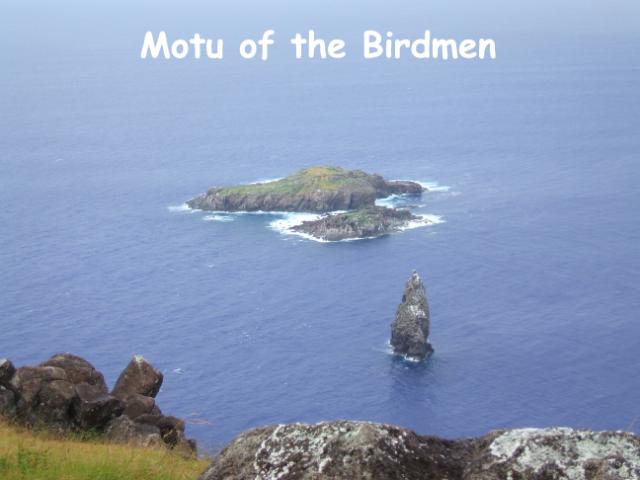 Off the headland are three small motu
(islands) used every year by nesting seabirds.
The young men must watch and wait, in their stone shelters, until the
first egg of the new season is laid. Then
the men must climb down the cliff, swim the channel, clamber on to the motu,
in a race to seize the egg. The
successful one swims back to Orango, bearing the egg in triumph, to become chief
for the next year. He carves a
petroglyph on a rock on the ridge between the sea and the volcano, making his
mark (half-man, half-bird) and signifying his birth (or rebirth) as a birdman.
It is an awesome prospect, but I can see merit in the system.
It would probably have prevented George W Bush and Tony Blair from taking
office. But oblivious of my
yet-to-be-formed opinion, the missionaries considered it a pagan ritual and put
an end to the birdman competition. Is
the world a better place as a result of the efforts of the Christian
missionaries? It is certainly a
duller one. I am still musing.
Of course, having read about the ritual doesnít automatically mean I
wasnít a birdman in a past life. I
cam almost feel the shock of the cold water, the exhilaration of the battle
against the strong currents and my rivals, the triumph of swimming back with the
precious egg in my mouth . . . Then
I probably sneezed.
Off the headland are three small motu
(islands) used every year by nesting seabirds.
The young men must watch and wait, in their stone shelters, until the
first egg of the new season is laid. Then
the men must climb down the cliff, swim the channel, clamber on to the motu,
in a race to seize the egg. The
successful one swims back to Orango, bearing the egg in triumph, to become chief
for the next year. He carves a
petroglyph on a rock on the ridge between the sea and the volcano, making his
mark (half-man, half-bird) and signifying his birth (or rebirth) as a birdman.
It is an awesome prospect, but I can see merit in the system.
It would probably have prevented George W Bush and Tony Blair from taking
office. But oblivious of my
yet-to-be-formed opinion, the missionaries considered it a pagan ritual and put
an end to the birdman competition. Is
the world a better place as a result of the efforts of the Christian
missionaries? It is certainly a
duller one. I am still musing.
Of course, having read about the ritual doesnít automatically mean I
wasnít a birdman in a past life. I
cam almost feel the shock of the cold water, the exhilaration of the battle
against the strong currents and my rivals, the triumph of swimming back with the
precious egg in my mouth . . . Then
I probably sneezed.
We walk past the huts which remind us of Skarra Brae, although the Orkney houses
are much older. We reach the lip of
the volcano and wait our turn to look at the carvings.
They have eroded badly with the wind and the rain, but there is something
primitive and timeless about them. In
front, the sheer drop to the sea and the bird islands.
Behind, the steep side of the crater of Rano Kau, 1,000m across, the
surface a long way below us mostly covered with water, 200m deep in the middle.
It is a wild place, there is rain in the wind, and it is 1,000 miles to
the nearest neighbour (Pitcairn) and 2,000 miles to the nearest population
centre. We are standing on the
remotest spot on earth.
The next stop is Ana Kai Tangata, where there is a cave with 15th century rock
paintings. The sea fills the cave
every day and the paintings have almost disappeared.
We take photos without much optimism.
On the way back we stop to look down on the airport, with Hanga Roa
beyond. There are distant views to
the north-east, across a green and pleasant island.
Coming back into town we ask to be dropped at the Post Office rather than
the hotel, and just make it before it closes.
We hand over our postcards and pay the extra $1 to have our passports
stamped with
We have lunch in a restaurant in town, with a view of the Hanga Roa moai
on the edge of the harbour. We only
want a snack, and once again we struggle with the menu.
We settle on a dish which has Coquilles san Jacques in the description.
It proves to be snack-size, small marinated scallops served with capers
and bread with mustard mayo and spicy diced onions.
We have slight misgivings when we realise that the scallops are uncooked.
I wonder uneasily if I will need my stick again tonight.
We buy chocolate on the way back to the hotel, and weíre ready for the
next tour in good time, as is Richard from
The first stop of the afternoon is the quarry at Puna Pau, the only place on the
island where the red rock used for the moai
topknots is found. There are several
topknots lying around in various stages of completion, abandoned when some
long-ago carvers downed tools. Some
are complete, at some short distance from the quarry.
They were abandoned on their journey to find the right head.
Then we are driven to Ahu Atio, also known as Ahu Akivi, where seven moai stand on their platform. (The
word ahu means platform.) They gaze
unblinkingly towards the point where the sun sets in the equinox.
We are thrilled: this is why we came to
Now we start heading west, and we are shown caves at Ana Te Pahu.
When the lava flowed and cooled several natural fissures were formed with
extensive tunnels and caves. The
islanders hid in these caves to avoid capture by the Peruvian slavers who came
looking for workers for their mines. It
wasnít an entirely successful tactic. The
population was decimated, not just by the departure of those captured but by the
diseases left by the Peruvians. The
caves do not look designed for comfort. Our
final stop of the afternoon is Ahu Vinapu, where there is a part-finished
platform that was being prepared for the biggest moai
of all. The huge blocks of rock fit
snugly together, and some experts think the skill involved shows a South
American influence. Elena thinks
otherwise. She is an islander
herself, and can trace her lineage back a long way.
She thinks the skills developed independently of each other, over 2,000
miles apart, and there appears to be no doubt that the people themselves are
Polynesian, not South American. There
is also a badly eroded standing stone depicting a female.
Elena tells us that the moai were created to commemorate clan chiefs, who were all men.
What position did this woman have, to warrant her likeness being carved
for posterity? We get back to the
minibus just before the heavens open, but the rain stops before we get back to
the hotel. I tell Elena that we
would like to go on the full day tour tomorrow, with picnic lunch.
Yes, she says, I have you booked for that.
I tell her I havenít paid for any of the trips, but she doesnít seem
concerned.
Unimpressed by my reaction to last nightís meal we decide to risk the weather
and walk into town for dinner. Before
we reach the town we see a restaurant with English words on the blackboard menu
outside. Itís not a wise choice,
for there is not much we fancy, but by now itís raining and we donít want to
walk even further from the hotel. We
settle for steak and chips, and whilst we wait they bring us some kind of
tortilla puffs rather than bread, and theyíre quite nice.
Whilst we are eating the steak the rain gets heavier and starts to blow
onto the tables at the front of the veranda.
The staff move the tables and chairs towards the back.
The steak is gristly, and Sue canít eat much of it.
Just off the veranda a dog sits in the pouring rain, waiting patiently
for scraps. It gets most of Sueís
steak. Still hungry, Sue decides she
will have a desert, but before we can order it we are forced back as well.
There are just two tables being used, and we all huddle against the wall
of the restaurant. We would go
inside, but there arenít any tables inside, just the kitchen.
We decide to forget desert and make a dash for it.
The waitress offers to get a taxi, which we decline.
Another mystery for
Sunday 25 February
It has rained all night and Sue is hoping that the tour will be cancelled.
It isnít, and off we go, after I have paid for the two days.
First stop is at Vaihu where we see fallen moai,
which is like seeing a neglected graveyard.
Except this isnít just neglect, the statues were pushed over
deliberately. They are so big (most
are between 12 feet and 20 feet high, and some weigh 80 or 90 tons) that the
toppling of hundreds, all over the island, must have taken a lot of time and
effort. It wasnít done in a
momentary fit of pique; somebody had to work very hard to push them all over.
These moai are by the sea, and
after the toppling further damage was caused by an earthquake in
Next comes the highlight of the tour: Ahu Tongariki.
This ahu is enormous,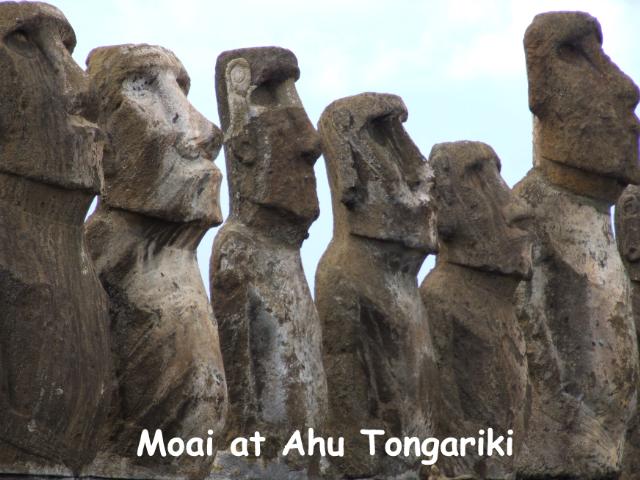 over 20 metres long, with 15 re-erected moai. One has a topknot.
They stand in line, facing inland, with their backs to a wide bay.
In the distance we can see a huge quarry face, where the stone for all
the moai on the island was cut.
There is also a solitary moai, not on a platform, who had been borrowed by the Japanese.
On his return to the island, the Japanese showed their gratitude by
funding the reconstruction of the platform and the fifteen moai
whose broken bodies had been scattered by the tsunami in 1960.
This is an eerie and majestic place.
I have an emotional reaction similar to that when I saw the terra cotta
warriors at Xian, and I am moved almost to tears.
over 20 metres long, with 15 re-erected moai. One has a topknot.
They stand in line, facing inland, with their backs to a wide bay.
In the distance we can see a huge quarry face, where the stone for all
the moai on the island was cut.
There is also a solitary moai, not on a platform, who had been borrowed by the Japanese.
On his return to the island, the Japanese showed their gratitude by
funding the reconstruction of the platform and the fifteen moai
whose broken bodies had been scattered by the tsunami in 1960.
This is an eerie and majestic place.
I have an emotional reaction similar to that when I saw the terra cotta
warriors at Xian, and I am moved almost to tears.
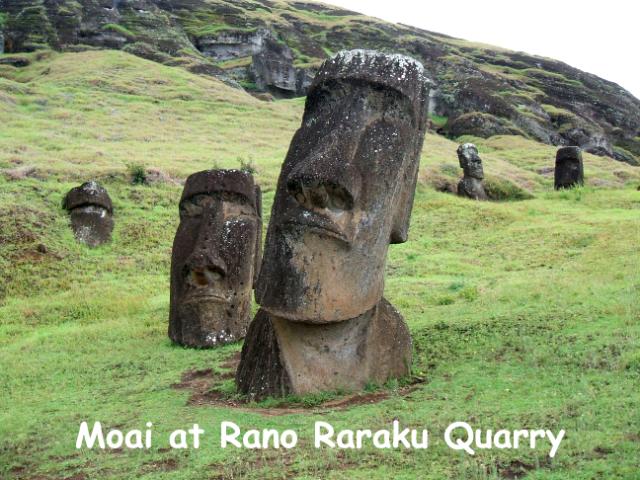 The minibus takes us near to the quarry at Rano Raraku.
We walk across the hillside, where statues have been abandoned as they
were being transported. Some are on
their backs, some standing, some partly buried, some at drunken angles.
At the quarry itself, we can see some that are unfinished, features
visible but still part of the bedrock. This
is work-in-progress. One of them was
destined to be the largest moai of
all, and we saw his platform yesterday at Ahu Vinapu.
The sheer scale of the operation is breathtaking.
There are almost 400 moai here.
The minibus takes us near to the quarry at Rano Raraku.
We walk across the hillside, where statues have been abandoned as they
were being transported. Some are on
their backs, some standing, some partly buried, some at drunken angles.
At the quarry itself, we can see some that are unfinished, features
visible but still part of the bedrock. This
is work-in-progress. One of them was
destined to be the largest moai of
all, and we saw his platform yesterday at Ahu Vinapu.
The sheer scale of the operation is breathtaking.
There are almost 400 moai here.
We wander back to the car park, which has tradersí stalls and picnic tables.
Our food has arrived in heated containers and we tuck into chicken, rice
and vegetables, followed by a banana. I
buy a shirt with a discreet image of a moai
and Sue buys souvenirs, and then itís back on the bus to Ah Te Pito Kura,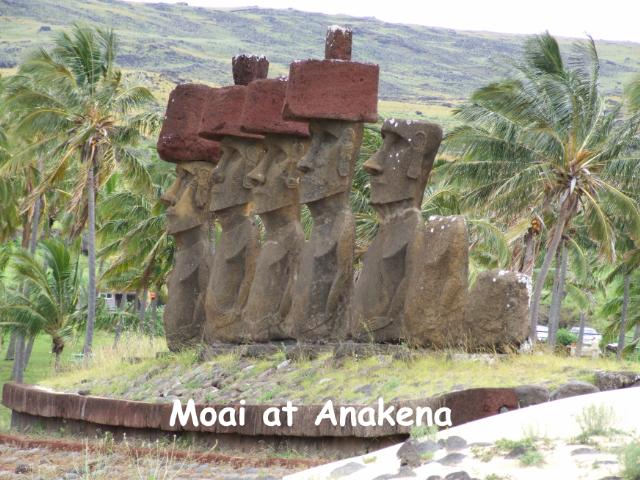 where Admiral Roggeveen saw the statues still standing in 1722, followed by the
beach at Anekena. Itís an idyllic
spot, with yellow sand, palm trees, and an ahu
with standing moai, several with
topknots. Itís a fitting end to
the day.
where Admiral Roggeveen saw the statues still standing in 1722, followed by the
beach at Anekena. Itís an idyllic
spot, with yellow sand, palm trees, and an ahu
with standing moai, several with
topknots. Itís a fitting end to
the day.
We get back to the hotel about 5.00 pm and having lost our room this morning we
have to rummage through our cases in the lobby, ask for towels, and shower and
change in the toilets. It has rained
on and off all day, although all the tour stops were between showers, but now we
are reluctant to go into town in case we get soaked again.
We eat at the hotel and I pay with the last of my Chilean pesos.
We have a few hours to wait for our ride to the airport, and we sit in
the lounge, reading, marking time. The
receptionist comes over with some news. Our
plane, the only plane of the day, has been delayed in
The plane takes off at 1.30 am, and we leave
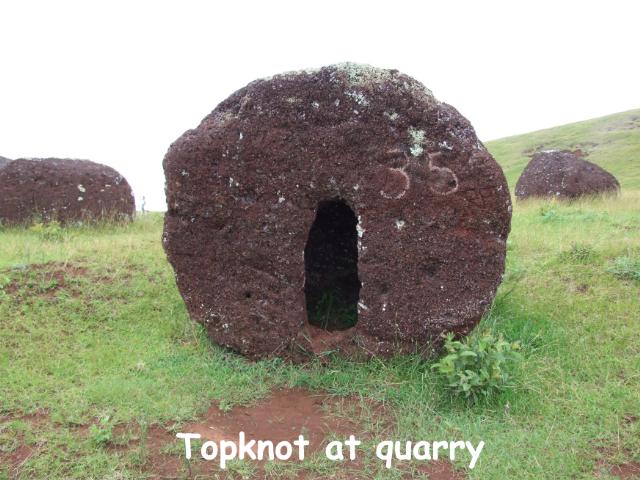 Next
leg:
Next
leg:
Easter
Island to